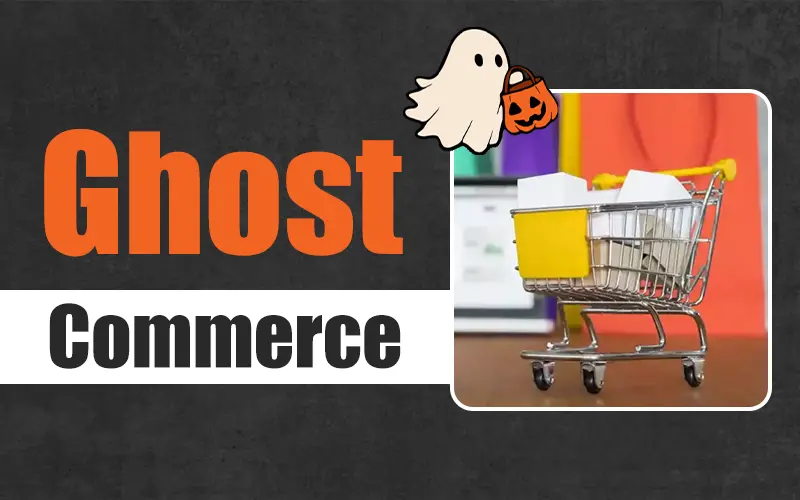You’re eager to start a business online. As you begin your research, every other search result claims to be about “the next big thing.” It’s easy to feel like you’re either late to the party or stuck in a sea of complicated options. Finding a simple, low-risk way to get started? That’s the real challenge.
Here is a way to run your business without getting tangled up in warehouses, shipping, or stock management. Enter ghost commerce, a rising trend making waves for all the right reasons. You might be wondering, “What is ghost commerce?” or “How do I start it?”—And we are here to answer.

Page overview:
How to Start Ghost Commerce Step by Step
Step 2: Select a Business Model
Step 3: Choose a Reliable Supplier
Step 5: Set Up Payment Methods
Step 6: Execute Marketing Strategies
Step 7: Fulfill Orders Quickly
Step 8: Use Data for Continuous Improvement
EPROLO: All-in-one Dropshipping Solution
What Is Ghost Commerce?
Ghost commerce may sound mysterious, but the is actually quite simple. It allows online businesses to operate without handling products, packing, or shipping. With this model, you to focus on what matters most: branding, marketing, and driving sales.
The key to starting ghost commerce is to set up a partnership with suppliers. A third party manages the inventory and logistics, so you can be free to grow your brand. This approach is perfect for those who want to start an online business with minimal upfront costs and risks.
Key Characteristics of Ghost Commerce
- No Inventory: You don’t need to hold any stock. Instead, your suppliers will handle all of that for you, shipping items directly to your customers.
- Heavily Rely on Suppliers: Ghost commerce businesses depend on reliable suppliers to fulfill orders and deliver products on time. Building strong relationships with them is essential.
- More Focus on Branding & Marketing: No need to deal with logistics free you up from the hassle. You can focus on creating a unique brand and promote it. This is where you will make your impact.
Common Types of Ghost Commerce
Here are the common types of ghost commerce:
- Dropshipping: You sell products from suppliers who fulfill orders directly to your customers, with no need to handle inventory yourself.
- Print-on-Demand: Custom products are printed only when a sale is made, so there’s no upfront inventory to manage.
- Affiliate Marketing: Affiliate marketing involves promoting other businesses’ products and earning a commission on each sale without handling the product itself.
- White-Labeling: You sell products produced by a third party but branded with your name. It’s your brand, but someone else does the heavy lifting.
Ghost commerce gives you the flexibility to run a business without the usual logistical headaches. This allows you to focus on what truly matters: building a brand people love.
Ghost Commerce vs. eCommerce
Ghost commerce differs most from the traditional form of eCommerce in how much you are involved in the nuts and bolts of the business. In traditional eCommerce, you have to manage inventory, pack, and ship these products yourself, or at least track them. It is time-consuming and requires an upfront investment in stock.
Ghost commerce takes out all the physical factors from your to-do list. You have nothing to do with the inventory and fulfillment since the suppliers take care of everything for you. Your role will be branding, marketing, and management of customer relations. In these, you are granted greater flexibility and liberty.
It’s a much lighter and low-risk way of venturing into the online business world. This allows you to focus on growth while others handle logistics. It is a much lighter and low-risk way of venturing into the online business world where you can focus on growth while some other person handles logistics.
How to Start Ghost Commerce Step by Step
Starting your own ghost commerce business might sound complicated, so breaking it down into steps can be more approachable. Let’s get started!
Step 1: Identify Your Niche
Before you start selling products online, you need to decide what you’re going to sell. This is where your decision on a niche comes in. A niche allows you to focus on a customer base with unique needs, which helps differentiate your brands.
Think about products that you’re really interested in or knowledge about, and then see if they’re in demand. The more focused your niche is, the bigger your chances are of standing out in a crowded marketplace.
Step 2: Select a Business Model
There are a variety of ghost commerce business models. Pick a model that best fits your skills and goals:
- Dropshipping: List products in your store and have your supplier ship the product directly to the customer upon purchase.
- Print-on-Demand: Print-on-demand is that you design customized prints that are printed only when an order is made; no need to keep stock.
- Affiliate Marketing: Promote other companies’ products while earning commissions based on every sale made through your referral links.
- White-Labeling: Sell other people’s products but still brand them as yours. You will handle marketing, and the manufacturer will take care of production and shipping.
Remember, every model has its advantages and disadvantages, and you must choose a model that best serves your long-term vision.

Step 3: Choose a Reliable Supplier
Once you have identified the niche and business model, you need to look for suppliers. The supplier is the backbone of your ghost commerce business. To find a good and reliable supplier, you can research through supplier directories, social media platforms, and forums.
When evaluating suppliers, prioritize those with excellent reviews, fast delivery times, and clear communication. Avoid suppliers who are slow to respond or inconsistent with shipping, as this can affect your customers’ experience.
A great option to consider is EPROLO, a trusted platform with global fulfillment services. EPROLO offers automated product sourcing and shipping. This makes it easier to manage your store without worrying about stock.
Step 4: Build an Online Store
When everything is in place, it’s time to set up your online store. Some platforms are pretty user-friendly, such as Shopify, WooCommerce, or BigCommerce. They allow you to build a professional-looking website without coding.
You can also choose to partner with existing platforms such as Amazon, eBay, or TikTok. The built-in traffic and tools allow you to place more attention on marketing.
Step 5: Set Up Payment Methods
Your customers need to pay you easily; you must have several payment options on your website. Some of the popular alternatives are PayPal, Stripe, and Shopify Payments. The more variants you give them, the easier it is for them to complete their purchase. Just ensure that your payment methods are secure because a lot of trust is built into shopping online.

Step 6: Execute Marketing Strategies
Marketing is the heart and soul of your ghost commerce business. Start by understanding your customers: who they are and what they care about. Then look through various channels available to reach them:
- Social Media: Utilize Instagram, Facebook, and TikTok ads to promote your products, interact with potential clients, and shape a brand community.
- Email Marketing: An email list is created to send promotions and updates to subscribers.
- Content Marketing: Create a blog or video content in your niche that informs users, builds trust, and boosts your store’s visibility.
- Influencer Marketing: Partner with an individual who has a significant following to promote your product.
Consistency is the secret to keeping attention. Whatever strategies you would choose, stay active and in touch with your audience regularly.
Step 7: Fulfill Orders Quickly
Once orders begin pouring in, you must fulfill them as fast as you can. This is where working with a good supplier with an automated fulfillment system comes into play.
Working with suppliers like EPROLO with an automated system, the order will be processed and shipped directly to your customer. You won’t miss the expected time to beat customer satisfaction.
Step 8: Use Data for Continuous Improvement
Running a ghost commerce business isn’t a “set it and forget it” situation. Use data to assess your store’s performance and find the areas for improvement.
Also, go through the customer feedback; it’s gold for insight. What are they saying about the products? Are they satisfied with the shipping times? For a business to always stay competitive, it shall continually improve based on feedback and performance data.

EPROLO: All-in-one Solution
Establishing a ghost commerce business is not easy, and you would require the best platform to assist you. EPROLO tends to make everything into a single solution. This helps save you time to concentrate more on branding and connecting with your customers.

Wide Product Selection & Strict Quality Control
EPROLO offers an awesome product in many different areas, so you’ve got your pick of something that fits your niche. What will help them stand out is a commitment to strict quality control. Selling high-quality products leads to fewer returns and greater customer satisfaction. Happy customers are repeat customers!
Global Warehouses for Fast Shipping
Speed is crucial in eCommerce, and EPROLO is well aware of this. Global warehouses ensure that your orders get shipped quickly to anywhere your customers are. Fast shipping helps to improve customer experience and gives you an edge over competitors.
Print-on-Demand Service
For those looking to add a personal touch to their products, EPROLO’s print-on-demand service is a game changer. You can create unique designs and have them printed only when an order is made.
Print-on-demand means you won’t have to worry about unsold inventory. This approach keeps your costs low and your creativity high.
White Label Service
Building a strong brand identity is essential, and EPROLO makes it easier with its white-label service. By branding the products, you can create a unique customer experience. This flexibility helps you establish a brand that stands out in a crowded market.
Seamless Integration and API
Setting up your store shouldn’t be a hassle. EPROLO offers seamless integration and API options, connecting effortlessly with popular eCommerce platforms such as:
This ease of integration means you can get your store up and running without a lot of technical headaches.

Pros & Cons of Ghost Commerce
Like any opportunity, ghost commerce comes with its own set of advantages and challenges. Let’s break it down to help you decide if this path is right for you.
Pros of Ghost Commerce
Here are the pros of ghost commerce:
- Passive Income: One of the biggest draws is the potential for passive income. Once your systems are set up everything, you can earn money while you sleep.
- Low Overhead Costs: Unlike traditional retail, ghost commerce requires little to no inventory, which keeps your overhead costs low. You don’t have to worry about rent for a physical store or paying for unsold products.
- Flexibility in Product Offerings: You have the freedom to choose what products to offer without being tied down to physical stock. This flexibility allows you to test new ideas and pivot based on market trends or customer feedback.
- Easy to Scale: As your business grows, scaling is relatively straightforward. You can expand your product range or target new markets without the logistical nightmares.
Cons of Ghost Commerce
Here are the cons of ghost commerce:
- Low Profit Margins: While low overhead is a plus, ghost commerce often comes with thinner profit margins. Competing on price can be tough, especially when multiple sellers offer the same products.
- High Competition: The barrier to entry is low, which means you’ll face fierce competition. Standing out can be a challenge, requiring creative marketing and a strong brand identity.
- Rely on Third Parties: Dependence on suppliers and fulfillment centers can lead to issues. If a supplier runs out of stock or makes a mistake, it can cause unhappy customer satisfaction.
- Expectation Management: Customers often expect quick shipping and high-quality products. Managing customer expectations during order delays or issues can be a challenging balancing act.
Weighing these pros and cons will help you make an informed decision about whether ghost commerce aligns with your business goals and risk tolerance.

Is Ghost Commerce Legit?
Absolutely! Ghost commerce is a legitimate business model that many entrepreneurs successfully use to make money online. However, like any business, ghost commerce has its fair share of challenges.
One of the biggest concerns is working with unreliable suppliers. If your supplier doesn’t deliver on time or sends faulty products, it can reflect poorly on your business. Additionally, there’s always a risk of selling illegal products, whether intentionally or by mistake. It’s crucial to do your research and ensure that the products you’re offering comply with local laws.
Also, make sure to have all the necessary legal pages on your site, like a clear return policy. Skipping these could lead to customer complaints or even legal trouble down the line. So, while ghost commerce is valid, being cautious and informed is key to running a successful venture.
Tips for Boosting Ghost Commerce
Setting up your ghost commerce business is just the beginning. To thrive in the competitive online market, consider these effective strategies that can help you stand out and drive sales.
Building a Strong Presence
Branding is essential for any business, and ghost commerce is no exception. Invest time and resources into developing a strong brand identity that resonates with your target audience. Create a professional website that reflects your brand and makes it easy for customers to browse and purchase products.
Don’t forget the power of social media! Engage with your audience by sharing content, responding to comments, and building a community around your brand. Personalization strategies, such as tailored marketing and product recommendations, make customers feel valued and increase return rates.
Using Data for Continuous Improvement
Data is a goldmine for improving your business. Regularly analyze customer behavior and sales patterns to identify what’s working and what’s not. Use this information to adjust your marketing strategies, product offerings, and customer service. Keeping an eye on trends can help you stay ahead of the competition and better meet your customers’ needs.
Focusing on Sustainability
Today’s consumers are increasingly eco-conscious, so consider incorporating sustainable practices into your supply chain and product offerings. This could mean sourcing products from ethical suppliers, using eco-friendly packaging, or promoting eco-friendly items. Highlighting your commitment to sustainability can attract like-minded customers and enhance your brand’s reputation.
Integrating Technologies
Embracing technology can significantly enhance your ghost commerce operations. Automate marketing and sales processes with tools designed for efficiency. For example, consider using AI-powered chatbots to answer questions, or guide users through the buying process. This not only improves customer satisfaction but also frees up your time for other tasks.
Additionally, leveraging blockchain technology can enhance transaction security. This provides peace of mind for both you and your customers.

Conclusion
Ghost commerce offers an exciting opportunity to start an online business with low overhead and great flexibility. By leveraging technology, building a strong brand presence, and focusing on sustainability, you can carve out a successful niche in the digital marketplace. This model is particularly appealing for entrepreneurs looking to minimize costs while maximizing their reach.
Whether you’re just starting out or looking to expand your business, ghost commerce provides a pathway to potential profit. So, take the plunge and start your ghost commerce adventure today!
FAQs
1. Can you really make money with ghost commerce?
Yes, many people successfully make money through ghost commerce. The key is to choose the right niche, build a strong online presence, and implement effective marketing strategies.
2. Is ghost commerce suitable for beginners?
Absolutely! Ghost commerce is beginner-friendly, as it requires minimal upfront investment and no inventory management. With some research and dedication, anyone can start.
3. What platforms are best for ghost commerce?
Popular platforms for ghost commerce include Shopify, WooCommerce, and Etsy. These platforms offer user-friendly interfaces and powerful tools to help you manage your online store.
4. How does ghost commerce differ from dropshipping?
Both models share similarities. Ghost commerce focuses more on branding and marketing with a wide range of products. While dropshipping is primarily about fulfilling orders without holding inventory. Ghost commerce emphasizes creating a unique customer experience, often with personalized marketing approaches.







